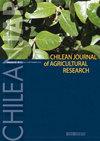Screening of some rice genotypes for salinity tolerance using agro-morphological and SSR markers
IF 1.7
4区 农林科学
Q2 Agricultural and Biological Sciences
引用次数: 0
Abstract
Salinity is a main obstacle of rice ( Oryza sativa L.) cultivation. Selecting rice genotypes for salinity tolerance based on phenotypic characteristics alone is inefficient and less reliable, finally will delay progress in rice breeding program. The recent advantages of molecular markers such as simple sequence repeat (SSR) could be used to detect associated salt tolerance markers in rice. This study was conducted to detect genetic variation within some rice genotypes using SSR markers and to identify salt tolerance in the studied genotypes. Forty-five rice genotypes were evaluated for their agro-morphological characteristics under non-stress and saline conditions for two growing seasons in 2018 and 2019. Using 21 SSR primers located on chromosome 8, only 18 SSR primer generated polymorphic patterns with a total of 76 alleles, whereas the other 3 primers were monomorphic. The number of alleles per locus ranged from 2 to 6 alleles with an average of 4.22 alleles per locus. The polymorphic information content (PIC) values varied from 0.30 (RM342) to 0.71 (RM6976) with an average PIC of 0.49. Out of the 18 polymorphic markers only 5 primers (RM 6976, RM7631, RM 5556, RM152 and RM342) perfectly distinguished rice genotypes. The best preforming genotypes under salinity stress were N22, IR 63731-1-1-4-3-2, GZ 7112-1-2-1-4, FL 478, TCCP 266-1-3B-10-2-1, IR 65600-127-6-2, IR 68011-15-1-1 and IR 66160-5-2-3-2. Thus, SSR markers are effective to detect high polymorphisms and variations among the rice genotypes, which could facilitate improving salt tolerance of commercial Egyptian rice varieties exhibiting high yield potential. In addition, the selected genotypes might be integrated into breeding programs for salinity tolerance. A marker’s high PIC value suggests a high probability of detecting the number of alleles between cultivars. A PIC value above 0.50 reveals a high degree of polymorphism. On this basis, the very good primers for this diversity analysis were RM408, RM5556, RM544, RM547, RM3395, RM6976, RM7631 and RM5545. The findings of this research indicate that the markers used are revealing and good for studies on genetic diversity. It is effective and cost-efficient to use microsatellites. They are abundant, co-dominant, highly reproducible and interspersed in the genome as compared with other markers. In particular, in rice genetic studies, microsatellite markers have been widely applied because they are capable of detecting high levels of allelic variation. The SSR markers play an important role in identifying salt tolerance genes that can be useful in developing new cultivars for plant breeders. In order to accelerate genetic advancement in rice, molecular markers could be used to tag QTL and determine their contributions to the phenotype by selecting desirable alleles at certain loci in the marker assisted selection (MAS) method. This is faster, more reliable and more cost-effective under saline field conditions than traditional screening (Aliyu et al., 2011). The results in this study indicate a great genetic resource for improving the salinity of rice in Egypt. In breeding programs to enhance rice materials for farmers, SSRs found here can be integrated. rice for then used assisted in利用农业形态和SSR标记筛选水稻耐盐基因型
盐分是水稻栽培的主要障碍。仅根据表型特征选择水稻耐盐基因型效率低,可靠性低,最终会推迟水稻育种计划的进展。利用分子标记的最新优势,如简单序列重复(SSR),可以检测水稻的相关耐盐标记。本研究旨在利用SSR标记检测某些水稻基因型的遗传变异,并鉴定所研究基因型的耐盐性。在2018年和2019年的两个生长季节,对45种水稻基因型在非胁迫和盐碱条件下的农业形态特征进行了评估。使用位于8号染色体上的21个SSR引物,只有18个SSR引物产生多态性,共有76个等位基因,而其他3个引物是单态的。每个基因座的等位基因数为2-6个,平均每个基因座有4.22个等位基因。多态性信息含量(PIC)值在0.30(342令吉)到0.71(6976令吉)之间变化,平均PIC为0.49。在18个多态性标记中,只有5个引物(RM6976、RM7631、RM5556、RM152和RM342)能完全区分水稻的基因型。在盐度胁迫下,最佳预成型基因型为N22、IR 63731-1-1-4-3-2、GZ 7112-1-2-1-4、FL 478、TCP 266-1-3B-102-1、IR 65600-127-6-2、IR 68011-15-1和IR 66160-5-2-3-2。因此,SSR标记可以有效地检测水稻基因型之间的高度多态性和变异,这有助于提高具有高产潜力的埃及商品水稻品种的耐盐性。此外,选择的基因型可能会被整合到耐盐育种计划中。标记的高PIC值表明检测到品种之间等位基因数量的可能性很高。PIC值高于0.50显示高度多态性。在此基础上,用于该多样性分析的非常好的引物是RM408、RM5556、RM544、RM547、RM3395、RM6976、RM7631和RM5545。这项研究的结果表明,所使用的标记具有揭示性,有利于遗传多样性的研究。使用微型卫星既有效又节省成本。与其他标记物相比,它们数量丰富,共显性,可重复性高,并散布在基因组中。特别是,在水稻遗传研究中,微卫星标记被广泛应用,因为它们能够检测高水平的等位基因变异。SSR标记在鉴定耐盐基因方面发挥着重要作用,可用于植物育种家开发新品种。为了加速水稻的遗传进步,分子标记可以用于标记QTL,并通过在标记辅助选择(MAS)方法中在某些位点选择所需的等位基因来确定它们对表型的贡献。在盐碱地条件下,这比传统的筛查更快、更可靠、更具成本效益(Aliyu等人,2011)。这项研究的结果表明,埃及有大量的遗传资源可以提高水稻的盐度。在为农民改良水稻材料的育种计划中,这里发现的SSR可以被整合。当时使用的大米
本文章由计算机程序翻译,如有差异,请以英文原文为准。
求助全文
约1分钟内获得全文
求助全文
来源期刊
CiteScore
3.00
自引率
11.80%
发文量
60
审稿时长
6 months
期刊介绍:
ChileanJAR publishes original Research Articles, Scientific Notes and Reviews of agriculture, multidisciplinary and agronomy: plant production, plant protection, genetic resources and biotechnology, water management, soil sciences, environment, agricultural economics, and animal production (focused in ruminant feeding). The editorial process is a double-blind peer reviewing, Editorial Office checks format, composition, and completeness, which is a requirement to continue the editorial process. Editorial Committee and Reviewers evaluate relevance and scientific merit of manuscript.

 求助内容:
求助内容: 应助结果提醒方式:
应助结果提醒方式:


